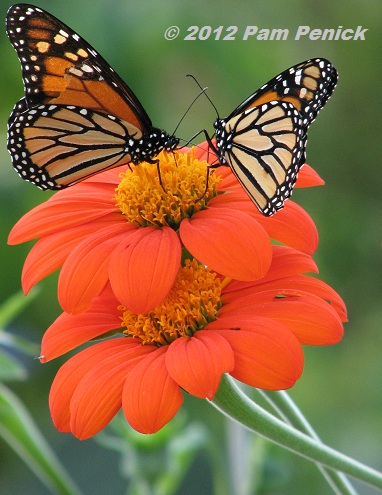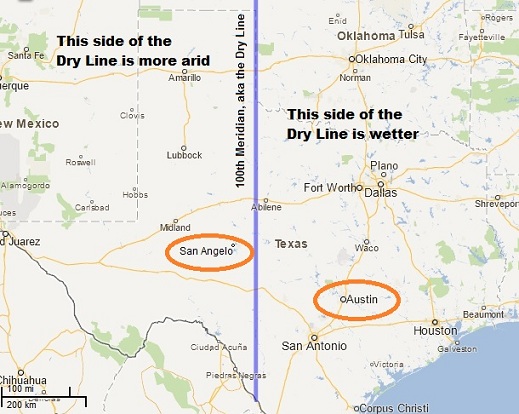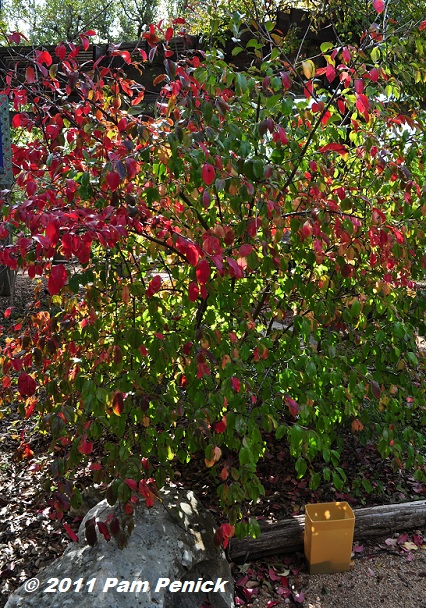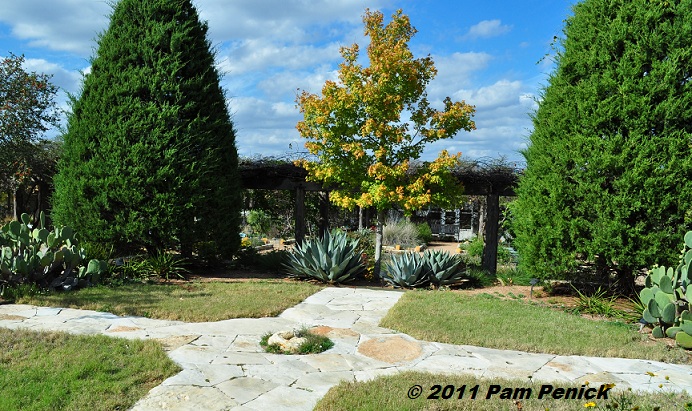Tom Spencer’s Tao of Texas gardening
As fall dances toward us, bearing cooler temperatures and gentle rains, we Texas gardeners have before us our easiest gardening season, with almost six months to get plants established (if we plant now) before the heat of summer returns. Still, last year, with its 90 days of plus-100-degree temperatures, extreme drought, and water rationing, scared us pretty badly. We enjoyed a reprieve this summer, and recent rains, but we’re still in a drought, and summers like last year’s are bound to return with more frequency. In response, lots of us are pulling out water-starved lawn grass and laying carpets of gravel accented with the occasional agave—an extreme reaction (even for agave lovers) considering our wetter-than-desert climate and the occasional flooding rainfall that central Texas is prone to.
Addressing the difficulties and the future of gardening in what’s likely to be a warmer, drier Texas, Tom Spencer, best known as the host of KLRU’s Central Texas Gardener, gave a free talk last Saturday at the Natural Gardener entitled “The Tao of Texas Gardening: Finding the Right Balance in the Lone Star State.” I found it inspiring and useful and want to share Tom’s main points with you.
Tom began by reminding us that gardening in central Texas presents many challenges, not least to our will and our energy. While in some blessed parts of the country you can stick a plant in the ground and walk away, you just can’t do that here. Even the most well-adapted plant has to be given a good start with regular water and perhaps also the addition of its most basic need—soil—since much of central Texas has only a thin layer of soil over limestone. We’re blasted by intense summer heat, but we also have sub-freezing temps in winter. As the saying goes, we’re always in drought, with an occasional flood. Despite these difficulties, as Tom pointed out, Austin is known to be a gardening mecca, with a plethora of well-stocked independent nurseries; radio and TV shows about gardening; a popular embrace of native plants, led by the Lady Bird Johnson Wildflower Center; and nationally acclaimed garden designers like Christy Ten Eyck, Mark Word, Lauren Springer Ogden, and James David. He thinks it’s partly because Austin attracts creative people and artists in many fields, and the creation of a garden is, of course, an art.
Tom sees a metaphor for central Texas gardening in the Tao’s yin-yang symbol—a yield/resist dynamic that is echoed in our desire to create beautiful gardens in this difficult climate while simultaneously trying not to get burned out from the effort. The yin-yang is echoed too in our climatic cycles of drought and flood, oppressive summer heat and fall-through-spring relief.
Even the east-west division of Texas along the 100th meridian—also known as the dry line, east of which lies the moist Southeast, west of which lies the arid Southwest—can be imagined as a yin-yang symbol, Tom suggested. And if climate change predictions for the next 50 years are correct, the dry line—which central Texas straddles, its gardens having long included both southeastern and southwestern plants—will shift to the east, and Austin will become increasingly drier and look more like San Angelo.
And yet, rather than responding by turning our yards into graveled expanses reminiscent of Arizona, Tom counseled that we should look to the western edges of the Texas Hill Country for plants that will prove suitable to our warmer, drier climate. Take Lost Maples State Natural Area, for example, which lies three hours southwest of Austin. We can look to its hot, dry highlands for plants for our sunnier gardens, or spaces that are farther from the hose.
But we can also look to its moist, sheltered canyons for plants for our woodland gardens and shady spaces. It’s a yin-yang push and pull, Tom said, between the two types of gardening, both of which are appropriate and sustainable for our gardening future.
In practical terms, how do we prepare for a drier future, while still anticipating the occasional monsoon year that we get thanks to our proximity to the Gulf of Mexico? Tom advised amending garden beds with plenty of granite, which provides essential drainage for those drier-loving plants. For dry, high-country-style beds, he suggested amending with 75% granite sand and 25% compost, and mulching with crushed granite. For shadier, canyon-floor-style beds, he suggested reversing that mixture to 75% compost and 25% granite sand, and mulching with a woody compost blend. For top-dressing and for paths, Tom recommended coarse, crushed granite rather than fine decomposed granite, noting that fine-textured D.G. can quickly become infested with weeds, which love to grow in it. Weeds have a harder time taking hold in a looser medium of coarse granite. Visit the stoneyard to see the difference, he advised, since suppliers may use different names to refer to their various gravels. It’s easy to end up with a delivery of 15 yards of fine D.G. in your driveway when you thought you’d ordered coarse granite—in fact, that happened to him once, he said.
Retama (Parkinsonia aculeata)
For the sunny, dry gardens—the Yin—of our future, Tom recommended the following plants.
Trees: Retama, desert willow, Mexican redbud, and Anacacho orchid tree. These take full sun and provide filtered shade for smaller plants growing beneath them.
Succulents and woody lilies: Paleleaf yucca, twistleaf yucca, Agave parryi, Agave parryi truncata, red yucca (both red- and yellow-flowering kinds), and sotol. These are small enough for the average garden and very drought tolerant.
Perennials, shrubs, and annuals: Cenizo/Texas sage, agarita, Autumn sage, Mexican bush sage, flame acanthus, four-nerve daisy, blackfoot daisy, pink skullcap, rock rose, rain lily, and bluebonnet.
Ornamental and turf grasses: Mexican feathergrass and buffalograss.
Rusty blackhaw viburnum (Viburnum rufidulum)
And for the shady, canyon-floor gardens—the Yang—of our future, Tom recommended these plants.
Trees and large shrubs: Monterrey oak, chinkapin oak, Lacey oak, Texas mountain laurel, Texas redbud, Texas persimmon, yaupon holly, possumhaw holly, rusty blackhaw viburnum, Mexican plum, Mexican buckeye, flameleaf sumac, and evergreen sumac.
Perennials, small shrubs, ferns, and annuals: Fragrant sumac, Turk’s cap, spiderwort, broadleaf salvias like Salvia guaranitica, Big Bend and Hill Country columbines, river fern, oxalis, oxblood lily, spider lily, and larkspur.
Ornamental grasses: Inland sea oats, Lindheimer muhly, and Gulf muhly.
Both styles of garden look to our immediate west, and both are xeric, although the canyon-floor garden is the wetter of the two.
Buffalograss lawn in a demonstration garden at the Wildflower Center
Tom also argued that there’s a place for appropriate lawn in the Austin garden. By “appropriate” he did not mean St. Augustine, which he no longer recommends due to its water needs. Rather he meant drought-tolerant grasses like buffalograss or, presumably, Habiturf—turf grasses that subsist on little supplemental water. He pointed out that lawn is often easier to take care of than a garden full of flowering perennials, and you should balance the practicality of what you can manage with your desire to create a dream garden. Tom’s own former dream garden, beautifully documented in his blog Soul of the Garden for many years, was big, lushly planted, and the envy of many who saw it on tour. It also required 20 hours of maintenance a week, he confided. That’s more than most people can do—more, it turns out, than he could do after a while. “If you can’t take care of it,” he said, “it’s not sustainable.”
Kempson Drive Garden in Austin
Tom summed up his philosophy for the future of gardening in central Texas with the reminder to look west—the western Hill Country, not so far west as Arizona—for plants for our gardens, and with a plea to continue to “be Austin.”
All material © 2006-2012 by Pam Penick for Digging. Unauthorized reproduction prohibited.







Outstanding! One of your best posts ever. Although I do not live on the Edwards Plateau, I live just east of that I-35 corridor. We have our own challenges, including not having the wealth of information that gardening in the Austin area has. I have found , though, that many of the plants that thrive there and are less water demanding thrive here also. Water is expensive here and a post like this really helps to think of ways to beat that cost and conserve a valuable resource that we all learned anew in `11 how fast can disappear.
Thanks for the compliment, Randy. I’m glad you found this post useful, though of course I’m just passing on what I heard at Tom’s talk. Lots of Austin gardeners are already growing the plants he recommends, but his talk really clarified, for me, a peaceful, less anxious way of responding, as a gardener, to our changing climate. I know gardeners who have given up. I know others in denial, trying to keep ill-suited plants going with lots of watering. And I see homeowners who have gone to the opposite extreme, graveling over their yards with very few plants. But Tom’s approach is Zen-like in its acceptance of what we cannot change, while still doing all we can to keep Austin looking like the Austin we know and love. —Pam
I thoroughly enjoyed reading this post. Although, the details are not appropriate for a Nashville garden, it’s time for me to implement changes. I know what I need to do and now I need to do it! It’s been predicted that our already extreme weather will become more extreme~heavier rains and drier summers. I wonder if Middle Tennessee has a Tom Spencer to help us make smart changes? gail
Gail, if you know what you need to do, then may I suggest that perhaps you are the Tom Spencer of Middle Tennessee? I bet you reach a lot of local gardeners with your wonderful blog. —Pam
Excellent ideas from Tom. Gardening in central Texas requires learning how to think about what to plant and going beyond just choosing from a list or selecting from the drought tolerant section of the nursery. I’ve learned this lesson more than a few times already. This has me thinking of various natural areas west of San Antonio I can visit to see what’s growing well. Thanks for sharing your notes with us.
My pleasure, Shirley. His philosophy and suggestions are definitely applicable to San Antonio, and probably many places beyond Texas, for that matter. Climate change is happening across the U.S. —Pam
So much here, but I appreciate how he terms “sustainable” in with maintenance ability. And the “Tao” / yin/yang approach. Not to mention the climatic variations, though climate change is evident everywhere as long as the earth has been here – but the plant communities nearby a given place have taken those ebbs and flows pretty well without irrigation, shearing, etc. Not that the latter are bad, but they are if life-support. Good post…I feel like I’m sitting down with fellow plant geography / climate nerd Pam Penick!
I thought the geography talk would be right up your alley, David. I thought of you when I was putting that map together. 😉 —Pam
Thanks for this post. This discussion should be going on all over the country. Where I am, they are projecting a wetter climate, though with more violent rainstorms.
Things are a-changing everywhere. It’ll be interesting to see how various regions evolve to meet the new gardening realities. —Pam
Thanks for passing this along, Pam. This kind of specific regional advice is a great model for other regions to use in assessing changing resources/climate issues. I miss reading about Tom’s old garden and wondered what happened to it.
Tom moved a few years ago, Denise, and left his garden to new owners. He stopped regularly updating his blog not long after he moved. I miss it too. —Pam
Wish I hadn’t missed Tom’s talk so I’m so glad you posted about it. (I was at the Natural Gardener at 9:30 am Saturday getting my pruners sharpened but didn’t have time to stay.) I’m glad to hear Tom understands not everyone wants a desert-like minimalist garden, not that there is anything wrong with this. I’m also glad to hear him say he spent 20 hours/week on his former garden. He was honest and I appreciate that too.
The dry Yin arrived in my garden in 2008, and the hardest part has been trying to make the garden planted before the drought transition to less rain. I have many of the plants listed above, and they are xeric but still need water from time to time. How often to water? I’m not sure. Yesterday, after 2 days and 5″ of rain (no exaggeration), when I dug 2″ beneath the leaf mulch in my garden, the soil was STILL dry. I was so surprised. Thank you for giving us this info.
You are so right that even our xeric-adapted plants need extra water to look their best (and sometimes even to survive) from time to time. And it’s hard to figure out the right balance between letting them tough it out and keeping them looking decent—we do want attractive gardens, after all. Gardening in Texas definitely isn’t for sissies, as they say! —Pam
I have to say that I really appreciate the viewpoint of “sustainable” as including maintenance. Considering I just spent the last two days doing yard work until it was too dark to see and am now in serious pain (it’s Gardening X-treme in my yard, yo), that is definitely something I need to keep in mind as my garden evolves.
In terms of plant choices, though, I’m glad that most of my later-developed front yard garden adheres to his guidelines. As for the back, that’s gonna have to change. I simply don’t have the time, energy, or money to keep up with my initial, less drought-tolerant plantings, as much as I love them.
I hear you, Lori. Like you, I spent a recent weekend working in my garden and paying for it for several days afterward. The body is not as young as it used to be! I also appreciated his reminder that a sustainable garden is one you have time to maintain. I’ve definitely shifted my gardens to include many more evergreens (including trees, shrubs, agaves, yuccas, and almost-evergreen grasses) than flowering perennials, which require a lot more cutting back. That shift was partly the result of moving to a shadier property, which doesn’t support the flowery cottage garden I used to grow, but when I saw how much less work it was, I made the conscious decision to keep on in that direction. —Pam
I’m so sorry I wasn’t able to join you for the talk. It sounds like Tom outdid himself again – bringing both wisdom, insight and insertion to the discussion. I agree with the other commenters that sustainable is a word I need to consider in my own garden. Mine simply isn’t sustainable any more, because of size more than anything, but maintenance needs are now part of my laundry list of considerations as I plan to replace or add plants, with drought tolerance, of course, being at the top of that list.
We’re always having to adjust the way we garden, whether because of climate considerations, young children, dogs, age, or other reasons. Lower maintenance is a goal most of us can get behind, and plant choices go a long way in helping with that. Good luck as you make changes to your plant palette! —Pam
Great info! My father-in-law and I had a talk about just that last year – how that line was moving east. I’m glad to see that I have many of the recommended plants already in place, and look forward to incorporating some of the rest.
Me too, Cynthia. —Pam
I wouldn’t worry too much about it. 🙂
Dry line will always swing back and forth. No thanks to negative PDO, we will see more and long lasting La Nina episodes for quite a while which often means droughts for Texas before PDO flips to positive giving us more El Ninos(more rain for Texas!). I still do all those things that you do though but I’m moving from old house from south of Dallas where I never experienced water restriction to new house in the hill country with water restriction. The only difference is that I have to water on certain days. I often water deeply every 10-14 days during hot and dry spell despite the fact I had st augustine grass. If people really understand what deep watering is then we wouldn’t be wasting so much water. I only water deeply to help trees grow. St augustine and other plants only benefited from that. I am more of tree person and want shade rather now than later. At the new house, I plan on drastically reducing size of lawn in the back and build plant beds all the around along the fence and keeping little patch of grass for my dog to sunbath on. Front yard will be a challenge as it faces north which you know means less sun in one area. Never had to deal with that in the past because at the old house, it was between houses that I never see. Maybe you have old posts over it? I’ll have to look through for some ideas of what to do with that.